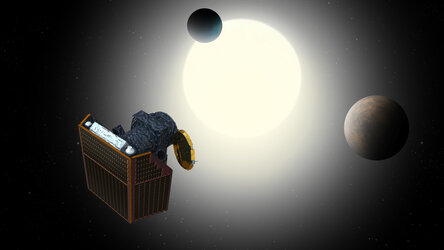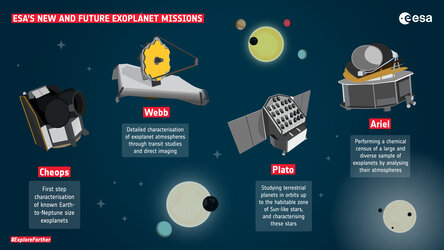Accept all cookies Accept only essential cookies See our Cookie Notice

About ESA
The European Space Agency (ESA) is Europe’s gateway to space. Its mission is to shape the development of Europe’s space capability and ensure that investment in space continues to deliver benefits to the citizens of Europe and the world.
Highlights
ESA - United space in Europe
This is ESA ESA facts Member States & Cooperating States Funding Director General Top management For Member State Delegations European vision European Space Policy ESA & EU Space Councils Responsibility & Sustainability Annual Report Calendar of meetings Corporate newsEstablishments & sites
ESA Headquarters ESA ESTEC ESA ESOC ESA ESRIN ESA EAC ESA ESAC Europe's Spaceport ESA ESEC ESA ECSAT Brussels Office Washington OfficeWorking with ESA
Business with ESA ESA Commercialisation Gateway Law at ESA Careers Cyber resilience at ESA IT at ESA Newsroom Partnerships Merchandising Licence Education Open Space Innovation Platform Integrity and Reporting Administrative Tribunal Health and SafetyMore about ESA
History ESA Historical Archives Exhibitions Publications Art & Culture ESA Merchandise Kids Diversity ESA Brand CentreLatest
Space in Member States
Find out more about space activities in our 23 Member States, and understand how ESA works together with their national agencies, institutions and organisations.
Science & Exploration
Exploring our Solar System and unlocking the secrets of the Universe
Go to topicAstronauts
Missions
Juice Euclid Webb Solar Orbiter BepiColombo Gaia ExoMars Cheops Exoplanet missions More missionsActivities
International Space Station Orion service module Gateway Concordia Caves & Pangaea BenefitsLatest
Space Safety
Protecting life and infrastructure on Earth and in orbit
Go to topicAsteroids
Asteroids and Planetary Defence Asteroid danger explained Flyeye telescope: asteroid detection Hera mission: asteroid deflection Near-Earth Object Coordination CentreSpace junk
About space debris Space debris by the numbers Space Environment Report In space refuelling, refurbishing and removingSafety from space
Clean Space ecodesign Zero Debris Technologies Space for Earth Supporting Sustainable DevelopmentLatest
Applications
Using space to benefit citizens and meet future challenges on Earth
Go to topicObserving the Earth
Observing the Earth Future EO Copernicus Meteorology Space for our climate Satellite missionsCommercialisation
ESA Commercialisation Gateway Open Space Innovation Platform Business Incubation ESA Space SolutionsLatest
Enabling & Support
Making space accessible and developing the technologies for the future
Go to topicBuilding missions
Space Engineering and Technology Test centre Laboratories Concurrent Design Facility Preparing for the future Shaping the Future Discovery and Preparation Advanced Concepts TeamSpace transportation
Space Transportation Ariane Vega Space Rider Future space transportation Boost! Europe's Spaceport Launches from Europe's Spaceport from 2012Latest

Exoplanet system
Thank you for liking
You have already liked this page, you can only like it once!
Artist’s impression of an exoplanet system.
ESA plans to launch three dedicated exoplanet satellites in the next decade, each tackling a unique aspect of exoplanet science: Cheops, Plato and Ariel.
The Characterising Exoplanet Satellite, Cheops, will observe bright, nearby stars that are already known to host exoplanets, focusing particularly on those with Earth- to Neptune-sized planets. It will make precise measurements of transiting planets in order to derive their density, and as such make a first-step characteristation of their nature and structure, discerning between rocky, icy, water or gas planets.
Plato, the PLAnetary Transits and Oscillations of stars mission, is a next-generation planet hunter with an emphasis on the properties of rocky planets in orbits up to the ‘habitable zone’ – where liquid water can exist on the planet’s surface – around Sun-like stars. It will also investigate seismic activity in stars. This will enable precise characterisation of the planet’s host star, including its age, providing insight into the age and evolutionary state of the planet system.
Ariel, the Atmospheric Remote-sensing Infrared Exoplanet Large-survey mission will take exoplanet characterisation one step further, performing a chemical census of a large and diverse sample of exoplanets by analysing their atmospheres. This will enable the study of exoplanets both as individuals and, importantly, as populations, in greater detail than ever.
Cheops will also help provide targets for other missions, including the international James Webb Space Telescope, which will be used to search for the signatures of water and methane, important elements in our quest for signs of habitability.
These missions will keep ESA at the forefront of exoplanet research well beyond the next decade, and will build on answering the fundamental question: what are the conditions for planet formation and the emergence of life?
-
CREDIT
ESA -
LICENCE
ESA Standard Licence

Cheops

Cheops

Cheops, ESA’s first exoplanet mission

ESA’s new and future exoplanet missions















 Germany
Germany
 Austria
Austria
 Belgium
Belgium
 Denmark
Denmark
 Spain
Spain
 Estonia
Estonia
 Finland
Finland
 France
France
 Greece
Greece
 Hungary
Hungary
 Ireland
Ireland
 Italy
Italy
 Luxembourg
Luxembourg
 Norway
Norway
 The Netherlands
The Netherlands
 Poland
Poland
 Portugal
Portugal
 Czechia
Czechia
 Romania
Romania
 United Kingdom
United Kingdom
 Slovenia
Slovenia
 Sweden
Sweden
 Switzerland
Switzerland
























